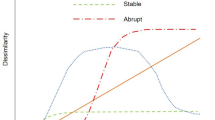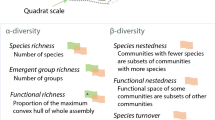Abstract
Rocky shore communities usually show complex patterns of compositional variation in space and time. Yet, this does not rule out the possibility of observing coherent temporal trends in aggregate community variables (e.g., biomass and number of species or individuals within functional groups or whole communities) due to broad-scale, seasonal, or interannual environmental controls that operate independently of local species composition. The goal of this study was to evaluate whether five aggregate community variables (mussel density, mussel biomass, algal biomass, macroinvertebrate density, and species density) show synchronous patterns of short-term, temporal variation (2 years) across eight rocky shore sites located in the Southwestern Atlantic and within two biogeographic regions (Warm Temperate Southwestern Atlantic and Magellanic). The study predictions were (1) that synchrony will increase as the spatial scale of analysis becomes smaller and, (2) that pairs of nearby sites will be more synchronized than pairs of distant ones. These predictions were weakly, if at all, supported by the data. Synchrony in aggregate community descriptors rarely occurred across the studied rocky shore sites. It can be observed at any spatial scale, and it can even fail to happen among sites located a few hundred meters apart. This suggests that local processes are overarching sources of short-term variability at the regional level, highlights the caution needed in generalizing from spatially limited time series data, and also underscores the potential limitations of climate envelope models to predict how aggregate community variables and related ecosystems functions (e.g., primary and secondary production) will respond to global climate change.




Similar content being viewed by others
References
Adami ML, Pastorino G, Orensanz JM (2013) Phenotypic differentiation of ecologically significant Brachidontes species co-occurring in intertidal mussel beds from the Southwestern Atlantic. Malacologia 56:59–67
Alvarado JL, Castilla JC (1996) Tridimensional matrices of mussels Perumytilus purpuratus on intertidal platforms with varying wave forces in central Chile. Mar Ecol Prog Ser 133:135–141
Archambault P, Bourget E (1999) Influence of shoreline configuration on spatial variation of meroplanktonic larvae, recruitment and diversity of benthic subtidal communities. J Exp Mar Biol Ecol 241:309–333
Arribas LP, Bagur M, Klein E, Penchaszadeh P, Palomo MG (2013) Geographic distribution of two mussel species and associated assemblages along the northern Argentinean coast. Aquat Biol 18:91–103
Arribas LP, Bagur M, Gutiérrez JL, Palomo MG (2015) Matching spatial scales of variation in mussel recruitment and adult densities across southwestern Atlantic rocky shores. J Sea Res 95:16–21
Arribas LP, Bagur M, Soria S, Gutiérrez JL, Palomo MG (2016) Competition between mussels at the rocky intertidal zone of La Lobería, Río Negro, Argentina. Revista del Museo Argentino de Ciencias Naturales 18:1–7
Bagur M, Richardson CA, Gutiérrez JL, Arribas LP, Doldan MS, Palomo MG (2013) Age, growth and mortality in four populations of the boring bivalve Lithophaga patagonica from Argentina. J Sea Res 81:49–56
Bagur M, Gutiérrez JL, Arribas LP, Palomo MG (2016) Complementary influences of co-occurring physical ecosystem engineers on species richness: insights from a Patagonian rocky shore. Biodivers Conserv 25:2787–2802
Benedetti-Cecchi L (2001) Variability in abundance of algae and invertebrates at different spatial scales on rocky sea shores. Mar Ecol Prog Ser 215:79–92
Broitman BR, Blanchette CA, Menge BA, Lubchenco J, Krenz C, Foley M, Raimondi PT, Lohse D, Gaines SD (2008) Spatial and temporal patterns of invertebrate recruitment along the west coast of the United States. Ecol Monogr 78:403–421
Buonaccorsi JP, Elkinton JS, Evans SR, Liebhold AM (2001) Measuring and testing for spatial synchrony. Ecology 82:1668–1679
Defriez EJ, Reuman DC (2017) A global geography of synchrony for marine phytoplankton. Global Ecol Biogeogr 26:867–877
Gouhier TC, Guichard F, Menge BA (2010) Ecological processes can synchronize marine population dynamics over continental scales. Proc Natl Acad Sci 107:8281–8286
Hammer Ø, Harper DAT (2006) Paleontological data analysis. Blackwell, Hoboken
Hammond W, Griffiths CL (2004) Influence of wave exposure on South African mussel beds and their associated infaunal communities. Mar Biol 144:547–552
Koenig WD (1999) Spatial autocorrelation of ecological phenomena. Trends Ecol Evol 14:22–26
Koenig WD (2002) Global patterns of environmental synchrony and the Moran effect. Ecography 25:283–288
Kokot RR, Codignotto JO, Elissondo M (2004) Vulnerabilidad al ascenso del nivel del mar en la costa de la provincia de Río Negro. Revista de la Asociación Geológica Argentina 59:477–487
Lagos NA, Tapia FJ, Navarrete SA, Castilla JC (2007) Spatial synchrony in the recruitment of intertidal invertebrates along the coast of central Chile. Mar Ecol Prog Ser 350:29–39
Legendre P, Legendre L (1998) Numerical ecology, 2nd edn. Elsevier Science, Amsterdam
Liebhold A, Koenig WD, Bjornstad ON (2004) Spatial synchrony in population dynamics. Annu Rev Ecol Evol Syst 35:467–490
Manly BFJ (1998) Randomization, bootstrap and Monte Carlo methods in biology. Chapman & Hall, London
Menconi M, Benedetti-Cecchi L, Cinelli F (1999) Spatial and temporal variability in the distribution of algae and invertebrates on rocky shores in the northwest Mediterranean. J Exp Mar Biol Ecol 233:1–23
Micheli F, Cottingham KL, Bascompte J, Bjornstad ON, Eckert GL, Fischer JM, Keitt TH, Kendall BE, Klug JL, Rusak JA (1999) The dual nature of community variability. Oikos 85:161–169
Navarrete SA, Wieters EA, Broitman BR, Castilla JC (2005) Scales of benthic–pelagic coupling and the intensity of species interactions: from recruitment limitation to top–down control. Proc Natl Acad Sci 102:18046–18051
Paiva PC (2001) Spatial and temporal variation of a nearshore benthic community in southern Brazil: implications for the design of monitoring programs. Estuar Coast Shelf Sci 52:423–433
Penchaszadeh PE (1973) Ecologia de la comunidad del mejillín (Brachydontes rodriguezi D’Orb.) en el mediolitoral rocoso de Mar del Plata (Argentina): El proceso de recolonización. Physis 32:51–64
Pfaff MC, Branch GM, Wieters EA, Branch RA, Broitman BR (2011) Upwelling intensity and wave exposure determine recruitment of intertidal mussels and barnacles in the southern Benguela upwelling region. Mar Ecol Prog Ser 425:141–152
Post E, Forchhammer MC (2002) Synchronization of animal population dynamics by large-scale climate. Nature 420:168–171
Rius M, McQuaid CD (2006) Wave action and competitive interaction between the invasive mussel Mytilus galloprovincialis and the indigenous Perna perna in South Africa. Mar Biol 150:69–78
Silliman BR, Bertness MD, Altieri AH, Griffin JN, Bazterrica MC, Hidalgo FJ, Crain CM, Reyna MV (2011) Whole-community facilitation regulates biodiversity on Patagonian rocky shores. PLoS One 6:e24502
Spalding MD, Fox HE, Allen GR, Davidson N, Ferdaña ZA, Finlayson MA, Halpern BS, Jorge MA, Lombana AL, Lourie SA, Martin KD (2007) Marine ecoregions of the world: a bioregionalization of coastal and shelf areas. Bioscience 57:573–583
Trovant B, Orensanz JM, Ruzzante DE, Stotz W, Basso NG (2015) Scorched mussels (Bivalvia: Mytilidae: Brachidontinae) from the temperate coasts of South America: Phylogenetic relationships, trans-Pacific connections and the footprints of Quaternary glaciations. Mol Phylogenet Evol 82:60–74
Underwood AJ, Chapman MG (1996) Scales of spatial patterns of distribution of intertidal invertebrates. Oecologia 107:212–224
Underwood AJ, Jernakoff P (1984) The effects of tidal height, wave-exposure, seasonality and rock-pools on grazing and the distribution of intertidal macroalgae in new south wales. J Exp Mar Biol Ecol 15:71–96
Ysebaert T, Herman PMJ (2002) Spatial and temporal variation in benthic macrofauna and relationships with environmental variables in an estuarine, intertidal soft-sediment environment. Mar Ecol Prog Ser 244:105–124
Zanon JE, Rodrigues L, Bini LM (2018) Hard to predict: Synchrony in epiphytic biomass in a floodplain is independent of spatial proximity, environmental distance, and environmental synchrony. Ecol Indic 93:379–386
Zar JH (1972) Significance testing of the Spearman rank correlation coefficient. J Am Stat Assoc 67:578–580
Acknowledgements
We thank Guido Pastorino for help in the taxonomic identification of mytilids, Diana Montemayor, Jesús Nuñez, Emiliano Ocampo, and Eleonor Tietze for housing during field trips. This is the contribution N° 113 of the Laboratorio de Reproducción y Biología Integrativa de Invertebrados Marinos (LARBIM) and to GrIETA’s program. This manuscript benefited from the comments of Associate Editor Patrik Kraufvelin and two anonymous reviewers.
Funding
The research presented here was partly funded by CONICET (Consejo Nacional de Investigaciones Científicas y Técnicas, Argentina; PIP 112-200801-00732 to MGP and JLG), and Total Foundation Funds to SARCE (South American Research Group on Coastal Ecosystems). MB and LPA were supported by CONICET doctoral fellowships.
Author information
Authors and Affiliations
Corresponding author
Ethics declarations
Conflict of interest
The authors declare that they have no conflict of interest.
Ethical approval
All applicable international, national, and/or institutional guidelines for the care and use of animals were followed. Collecting permits were provided by Secretaria de Medio Ambiente y Desarrollo Sustentable, Río Negro.
Additional information
Responsible Editor: P. Kraufvelin.
Publisher's Note
Springer Nature remains neutral with regard to jurisdictional claims in published maps and institutional affiliations.
Reviewed by undisclosed experts.
Electronic supplementary material
Below is the link to the electronic supplementary material.
Rights and permissions
About this article
Cite this article
Arribas, L.P., Gutiérrez, J.L., Bagur, M. et al. Variation in aggregate descriptors of rocky shore communities: a test of synchrony across spatial scales. Mar Biol 166, 44 (2019). https://doi.org/10.1007/s00227-019-3492-6
Received:
Accepted:
Published:
DOI: https://doi.org/10.1007/s00227-019-3492-6




